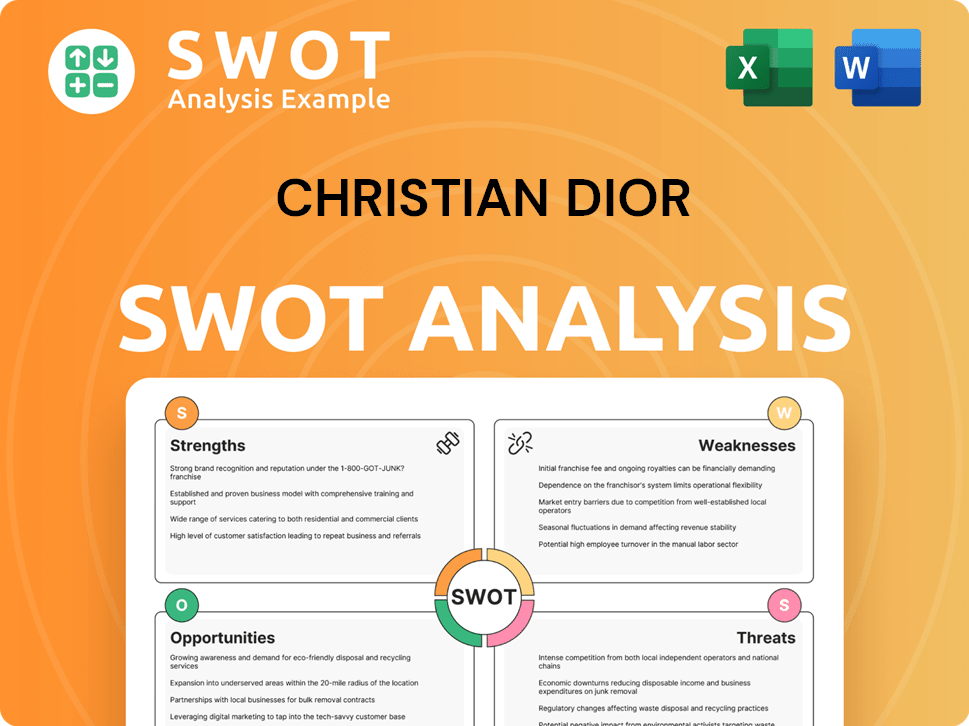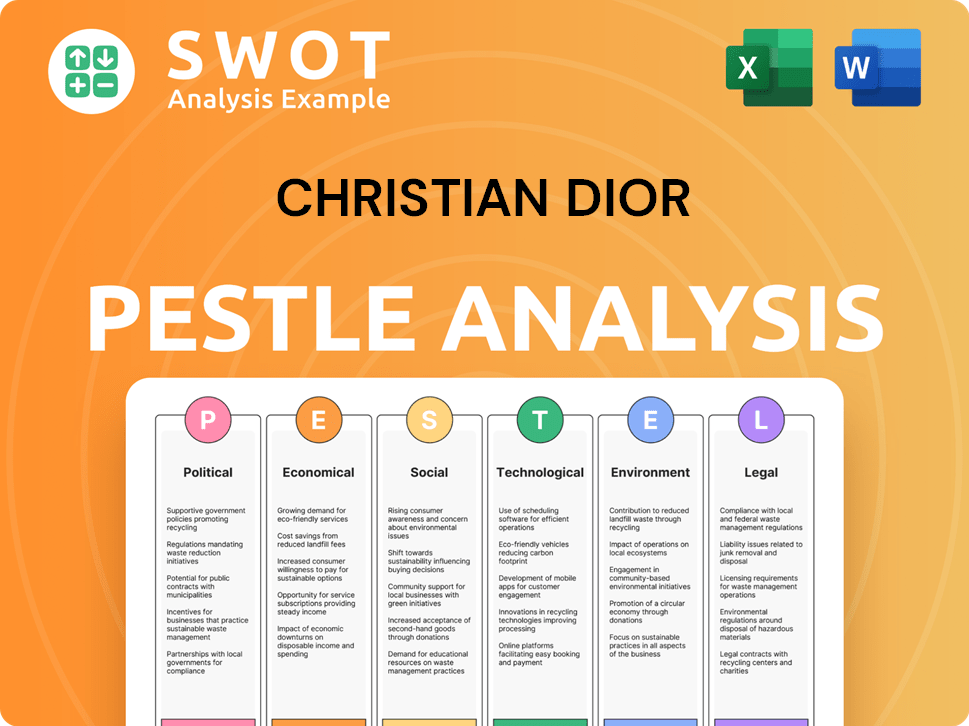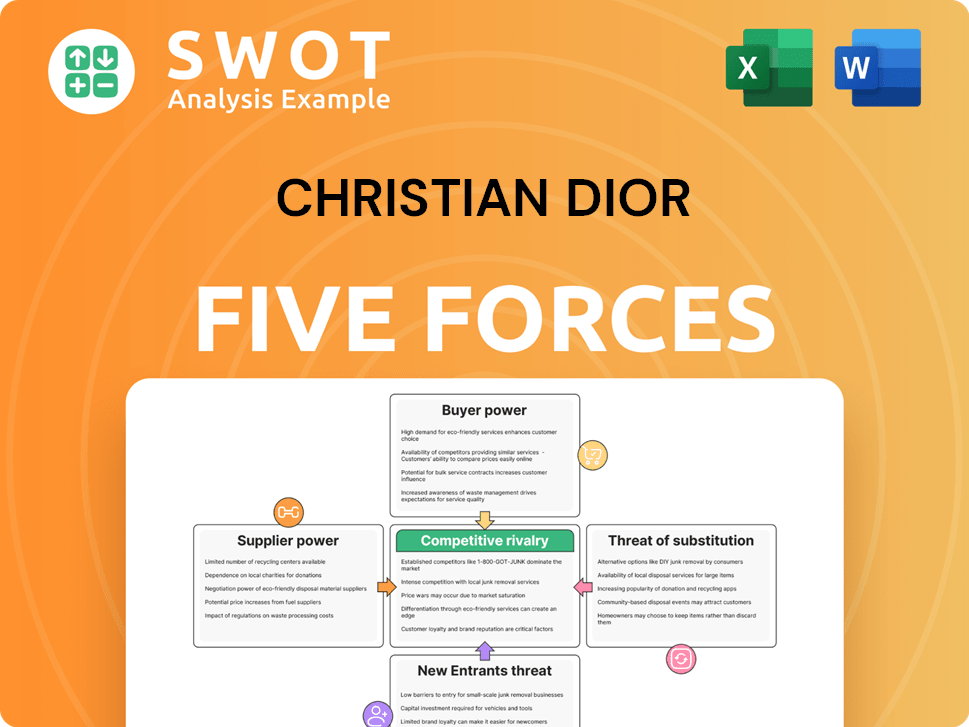Christian Dior Bundle
How Does the Dior Company Dominate Luxury?
Christian Dior, a cornerstone of luxury fashion, isn't just a brand; it's a global phenomenon. From haute couture to coveted Dior products, the French fashion house has captivated the world with its elegance and innovation. But how does this iconic company maintain its position at the pinnacle of luxury?

Delving into the Christian Dior SWOT Analysis reveals the intricacies of its operations, from design and manufacturing to marketing and distribution. Understanding the Dior brand's structure, including its history and evolution, is key to appreciating its enduring appeal. This article will explore how Dior manufactures its products, where they are made, and how it strategically markets its offerings to a discerning clientele, providing insights into the company's financial performance and revenue generation.
What Are the Key Operations Driving Christian Dior’s Success?
The Dior company operates as a leading luxury brand, creating and delivering value through its integrated design, manufacturing, and retail operations. Its core business encompasses a wide range of luxury products, including haute couture, ready-to-wear fashion, leather goods, accessories, footwear, jewelry, watches, fragrances, makeup, and skincare. This diverse portfolio caters to a global clientele that values exclusivity, superior craftsmanship, and the brand's rich heritage.
The operational processes of the Dior brand are meticulously managed, from conceptual design and sourcing of high-quality materials to precision manufacturing, rigorous quality control, and sophisticated global logistics. The brand's commitment to haute couture, while not a primary revenue driver, serves as the ultimate expression of its creativity and craftsmanship, reinforcing its luxury image and driving demand for its more accessible ready-to-wear and accessory lines.
The supply chain is highly integrated, often involving long-term relationships with specialized artisans and suppliers to ensure the highest quality and exclusivity of materials. Distribution occurs primarily through a global network of directly operated boutiques, high-end department stores, and curated online platforms, ensuring a premium customer experience. This approach enables the Dior company to offer products that are symbols of status, artistry, and timeless elegance, setting it apart from competitors.
Dior offers a wide array of luxury goods. These include haute couture, ready-to-wear clothing, leather goods, and accessories. The brand also provides footwear, jewelry, watches, fragrances, makeup, and skincare products.
The company focuses on design, manufacturing, and retail. It emphasizes high-quality materials, precision manufacturing, and stringent quality control. Global logistics and direct-to-consumer retail ensure a premium customer experience.
Dior maintains long-term relationships with artisans and suppliers. Products are distributed through boutiques, department stores, and online platforms. This strategy ensures exclusivity and a premium brand image.
Haute couture serves as the ultimate expression of creativity and craftsmanship. It reinforces the luxury image of the brand. This drives demand for ready-to-wear and accessory lines.
The Dior brand stands out through its commitment to luxury and exclusivity. This is achieved through high-quality materials, craftsmanship, and a focus on the customer experience. The brand's heritage and status further enhance its appeal.
- Commitment to Haute Couture: This reinforces the brand's luxury image.
- Integrated Supply Chain: Ensures quality and exclusivity of materials.
- Global Retail Network: Provides a premium customer experience.
- Brand Heritage: A long history of artistry and design.
For more information about the ownership structure of the company, you can read this article about Owners & Shareholders of Christian Dior.
Christian Dior SWOT Analysis
- Complete SWOT Breakdown
- Fully Customizable
- Editable in Excel & Word
- Professional Formatting
- Investor-Ready Format

How Does Christian Dior Make Money?
The Dior company generates revenue primarily through the sale of luxury goods. This includes a wide range of products, from fashion and leather goods to perfumes, cosmetics, watches, and jewelry. The Dior brand strategically employs various methods to maximize its financial performance and maintain its position in the luxury market.
The primary revenue streams for Christian Dior are diverse, encompassing several key product categories. These categories include fashion and leather goods, perfumes and cosmetics, watches and jewelry, and other retail activities. While specific financial breakdowns for Christian Dior SE are often consolidated within LVMH's reporting, the Fashion & Leather Goods segment, which includes Dior, made a significant contribution to LVMH's total revenue of €86.2 billion in 2023.
The Dior company employs several monetization strategies to drive revenue and maintain its brand prestige. These strategies include premium pricing, licensing agreements, tiered pricing, cross-selling, and direct-to-consumer sales.
The Dior brand uses several strategies to boost revenue and maintain its brand image. These strategies include premium pricing for exclusive collections, licensing agreements for fragrances and cosmetics, and a tiered pricing approach to cater to different customer segments. Furthermore, the company focuses on direct sales through its boutiques and e-commerce platforms.
- Premium Pricing: Haute couture and ready-to-wear collections are priced to reflect craftsmanship and brand prestige.
- Licensing: Licensing agreements for fragrances and cosmetics leverage the brand's global recognition.
- Tiered Pricing: A tiered pricing strategy is used across product lines, offering luxury at various price points.
- Cross-Selling: Within boutiques, cross-selling encourages customers to purchase complementary items.
- Direct-to-Consumer Sales: A global network of boutiques and e-commerce platforms maximizes profit margins and controls the brand experience. For more insights into the company's origins, check out Brief History of Christian Dior.
Christian Dior PESTLE Analysis
- Covers All 6 PESTLE Categories
- No Research Needed – Save Hours of Work
- Built by Experts, Trusted by Consultants
- Instant Download, Ready to Use
- 100% Editable, Fully Customizable

Which Strategic Decisions Have Shaped Christian Dior’s Business Model?
The story of the Dior brand is defined by key milestones, strategic moves, and a strong competitive edge. Established in 1946, the French fashion house quickly revolutionized post-war fashion with its 'New Look', establishing itself as a leading couture house. The company's evolution has been marked by strategic expansions and adaptations to market changes, ensuring its continued relevance and profitability in the luxury fashion industry.
Dior's ability to maintain brand exclusivity while innovating its product offerings and digital presence has been crucial. The brand's integration into the LVMH luxury conglomerate significantly boosted its financial backing and global expansion capabilities. This strategic alignment has allowed Dior to leverage synergies across various luxury brands, enhancing its competitive advantage in the global market.
The Dior company has consistently adapted to evolving consumer behaviors. This includes embracing digital transformation, expanding e-commerce capabilities, and engaging with new generations of luxury consumers through innovative marketing and product collaborations. This approach ensures sustained relevance and profitability. Understanding the Competitors Landscape of Christian Dior provides additional context to its market position.
The founding of Dior in 1946 and the 'New Look' in 1947 were pivotal. These events redefined fashion post-World War II. Strategic expansions into ready-to-wear, accessories, and fragrances broadened its appeal.
Diversification into various product categories, including ready-to-wear and beauty, expanded revenue streams. The acquisition by LVMH in the late 1980s provided financial strength and global reach. Digital transformation and e-commerce expansion are ongoing strategies.
Unparalleled brand strength and heritage allow for premium pricing and customer loyalty. Technological leadership in design and manufacturing enhances efficiency. The 'ecosystem effect' within LVMH boosts its competitive position.
Dior's financial success is reflected in its consistent revenue growth. Specific figures are often consolidated within LVMH's overall financial reports. LVMH reported revenue of €86.2 billion in 2023, a 13% increase compared to 2022.
Dior's operations are characterized by a focus on luxury and exclusivity. This includes meticulous design processes, high-quality manufacturing, and selective distribution. The brand's marketing strategies emphasize brand heritage and aspirational lifestyles.
- Design and Manufacturing: Dior's collections are designed in Paris and often manufactured in Italy and France.
- Distribution: Dior products are sold through a network of directly operated stores, online platforms, and select wholesale partners.
- Marketing: Dior uses high-profile advertising campaigns, celebrity endorsements, and collaborations to maintain brand visibility.
- Sustainability: Dior is increasingly focusing on sustainable practices, including responsible sourcing and eco-friendly packaging.
Christian Dior Business Model Canvas
- Complete 9-Block Business Model Canvas
- Effortlessly Communicate Your Business Strategy
- Investor-Ready BMC Format
- 100% Editable and Customizable
- Clear and Structured Layout

How Is Christian Dior Positioning Itself for Continued Success?
The Dior company, through its parent company Christian Dior SE, holds a prominent position in the luxury goods industry. This is largely due to its controlling stake in LVMH Moët Hennessy Louis Vuitton, the world's largest luxury group. This strategic affiliation provides access to a vast global network and a diverse portfolio of luxury brands.
The Dior brand benefits from LVMH's extensive reach across various luxury segments, including fashion, leather goods, perfumes, cosmetics, watches, jewelry, and selective retailing. This structure allows the Dior company to leverage robust supply chains and a strong brand portfolio, contributing to its high customer loyalty. This loyalty is driven by the brand's heritage, exclusivity, and consistent delivery of high-quality products.
Christian Dior benefits significantly from its association with LVMH, the world's leading luxury group. LVMH's diverse portfolio and global presence support Dior's market position. The brand's strong heritage and high-quality products contribute to its loyal customer base.
Potential risks include shifts in consumer preferences, economic downturns, and geopolitical instability. Regulatory changes regarding sustainability and ethical sourcing also pose challenges. These factors could impact the brand's performance and market share.
The outlook for Christian Dior remains positive, with a focus on leveraging its iconic brand and expanding its global footprint. Innovation in product offerings and digital transformation are key strategies. The brand is well-positioned to maintain and grow revenue in the luxury market.
LVMH's strategic initiatives, which Christian Dior is inherently part of, include continued investment in digital platforms. Expansion into emerging markets and enhancing customer experience are also key. These efforts aim to strengthen the brand's market position.
Christian Dior's association with LVMH provides significant advantages, including access to resources and a global distribution network. However, the brand faces challenges related to changing consumer preferences and economic uncertainties. Understanding these dynamics is crucial for future growth.
- Leveraging LVMH's global infrastructure for expansion.
- Adapting to evolving consumer demands for sustainable practices.
- Investing in digital platforms to enhance customer engagement.
- Navigating economic and geopolitical risks in key markets.
The luxury market, in which Dior products compete, is influenced by global economic trends and consumer behavior. As detailed in the Growth Strategy of Christian Dior, the company's success depends on its ability to adapt to these changes. Recent reports indicate that the luxury market is experiencing fluctuations, with some segments showing strong growth while others face challenges. For example, the personal luxury goods market, which includes fashion and accessories, is projected to reach approximately $405 billion in 2025, according to recent market analysis. This growth is driven by increasing demand in emerging markets and the continued appeal of established brands like Dior. Furthermore, the shift towards digital channels and sustainable practices is reshaping the industry. Dior's ability to integrate these elements into its operations will be critical for maintaining its competitive edge.
Christian Dior Porter's Five Forces Analysis
- Covers All 5 Competitive Forces in Detail
- Structured for Consultants, Students, and Founders
- 100% Editable in Microsoft Word & Excel
- Instant Digital Download – Use Immediately
- Compatible with Mac & PC – Fully Unlocked

Related Blogs
- What are Mission Vision & Core Values of Christian Dior Company?
- What is Competitive Landscape of Christian Dior Company?
- What is Growth Strategy and Future Prospects of Christian Dior Company?
- What is Sales and Marketing Strategy of Christian Dior Company?
- What is Brief History of Christian Dior Company?
- Who Owns Christian Dior Company?
- What is Customer Demographics and Target Market of Christian Dior Company?
Disclaimer
All information, articles, and product details provided on this website are for general informational and educational purposes only. We do not claim any ownership over, nor do we intend to infringe upon, any trademarks, copyrights, logos, brand names, or other intellectual property mentioned or depicted on this site. Such intellectual property remains the property of its respective owners, and any references here are made solely for identification or informational purposes, without implying any affiliation, endorsement, or partnership.
We make no representations or warranties, express or implied, regarding the accuracy, completeness, or suitability of any content or products presented. Nothing on this website should be construed as legal, tax, investment, financial, medical, or other professional advice. In addition, no part of this site—including articles or product references—constitutes a solicitation, recommendation, endorsement, advertisement, or offer to buy or sell any securities, franchises, or other financial instruments, particularly in jurisdictions where such activity would be unlawful.
All content is of a general nature and may not address the specific circumstances of any individual or entity. It is not a substitute for professional advice or services. Any actions you take based on the information provided here are strictly at your own risk. You accept full responsibility for any decisions or outcomes arising from your use of this website and agree to release us from any liability in connection with your use of, or reliance upon, the content or products found herein.